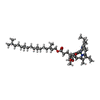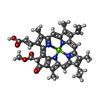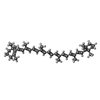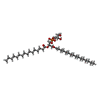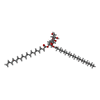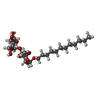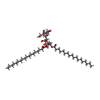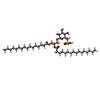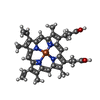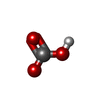[English] 日本語
 Yorodumi
Yorodumi- EMDB-62499: PSII-FCPII supercomplex from haptophyte Chrysotila roscoffensis -
+ Open data
Open data
- Basic information
Basic information
| Entry |  | |||||||||
|---|---|---|---|---|---|---|---|---|---|---|
| Title | PSII-FCPII supercomplex from haptophyte Chrysotila roscoffensis | |||||||||
 Map data Map data | Cryo-EM map of a PSII-FCPII supercomplex from haptophyte Chrysotila roscoffensis. | |||||||||
 Sample Sample |
| |||||||||
 Keywords Keywords | photosystem II / photosynthesis / chlorophyll / light-harvesting complex / energy transfer / LHCII / FCPII / coccolithophore / haptophyte | |||||||||
| Function / homology |  Function and homology information Function and homology informationthylakoid membrane / photosynthesis, light harvesting / photosystem II reaction center / photosystem II / photosynthetic electron transport chain / photosystem II / response to herbicide / chlorophyll binding / photosynthetic electron transport in photosystem II / : ...thylakoid membrane / photosynthesis, light harvesting / photosystem II reaction center / photosystem II / photosynthetic electron transport chain / photosystem II / response to herbicide / chlorophyll binding / photosynthetic electron transport in photosystem II / : / chloroplast thylakoid membrane / photosynthesis / chloroplast / electron transfer activity / oxidoreductase activity / iron ion binding / heme binding / metal ion binding / membrane Similarity search - Function | |||||||||
| Biological species |  Chrysotila roscoffensis (eukaryote) Chrysotila roscoffensis (eukaryote) | |||||||||
| Method | single particle reconstruction / cryo EM / Resolution: 2.22 Å | |||||||||
 Authors Authors | La Rocca R / Kato K / Tsai P-C / Nakajima Y / Akita F / Shen J-R | |||||||||
| Funding support | 1 items
| |||||||||
 Citation Citation |  Journal: Nat Commun / Year: 2025 Journal: Nat Commun / Year: 2025Title: Structure of a photosystem II-FCPII supercomplex from a haptophyte reveals a distinct antenna organization. Authors: Romain La Rocca / Koji Kato / Pi-Cheng Tsai / Yoshiki Nakajima / Fusamichi Akita / Jian-Ren Shen /  Abstract: Haptophytes are unicellular algae that produce 30 to 50% of biomass in oceans. Among haptophytes, a subset named coccolithophores is characterized by calcified scales. Despite the importance of ...Haptophytes are unicellular algae that produce 30 to 50% of biomass in oceans. Among haptophytes, a subset named coccolithophores is characterized by calcified scales. Despite the importance of coccolithophores in global carbon fixation and CaCO production, their energy conversion system is still poorly known. Here we report a cryo-electron microscopic structure of photosystem II (PSII)-fucoxanthin chlorophyll c-binding protein (FCPII) supercomplex from Chyrostila roscoffensis, a representative of coccolithophores. This complex has two sets of six dimeric and monomeric FCPIIs, with distinct orientations. Interfaces of both FCPII/FCPII and FCPII/core differ from previously reported. We also determine the sequence of Psb36, a subunit previously found in diatoms and red algae. The principal excitation energy transfer (EET) pathways involve mainly 5 FCPIIs, where one FCPII monomer mediates EET to CP47. Our findings provide a solid structural basis for EET and energy dissipation pathways occurring in coccolithophores. | |||||||||
| History |
|
- Structure visualization
Structure visualization
| Supplemental images |
|---|
- Downloads & links
Downloads & links
-EMDB archive
| Map data |  emd_62499.map.gz emd_62499.map.gz | 675.4 MB |  EMDB map data format EMDB map data format | |
|---|---|---|---|---|
| Header (meta data) |  emd-62499-v30.xml emd-62499-v30.xml emd-62499.xml emd-62499.xml | 40.3 KB 40.3 KB | Display Display |  EMDB header EMDB header |
| FSC (resolution estimation) |  emd_62499_fsc.xml emd_62499_fsc.xml | 19.8 KB | Display |  FSC data file FSC data file |
| Images |  emd_62499.png emd_62499.png | 124.2 KB | ||
| Masks |  emd_62499_msk_1.map emd_62499_msk_1.map | 824 MB |  Mask map Mask map | |
| Filedesc metadata |  emd-62499.cif.gz emd-62499.cif.gz | 9.8 KB | ||
| Others |  emd_62499_half_map_1.map.gz emd_62499_half_map_1.map.gz emd_62499_half_map_2.map.gz emd_62499_half_map_2.map.gz | 764.5 MB 764.6 MB | ||
| Archive directory |  http://ftp.pdbj.org/pub/emdb/structures/EMD-62499 http://ftp.pdbj.org/pub/emdb/structures/EMD-62499 ftp://ftp.pdbj.org/pub/emdb/structures/EMD-62499 ftp://ftp.pdbj.org/pub/emdb/structures/EMD-62499 | HTTPS FTP |
-Validation report
| Summary document |  emd_62499_validation.pdf.gz emd_62499_validation.pdf.gz | 1.2 MB | Display |  EMDB validaton report EMDB validaton report |
|---|---|---|---|---|
| Full document |  emd_62499_full_validation.pdf.gz emd_62499_full_validation.pdf.gz | 1.2 MB | Display | |
| Data in XML |  emd_62499_validation.xml.gz emd_62499_validation.xml.gz | 29.9 KB | Display | |
| Data in CIF |  emd_62499_validation.cif.gz emd_62499_validation.cif.gz | 39.4 KB | Display | |
| Arichive directory |  https://ftp.pdbj.org/pub/emdb/validation_reports/EMD-62499 https://ftp.pdbj.org/pub/emdb/validation_reports/EMD-62499 ftp://ftp.pdbj.org/pub/emdb/validation_reports/EMD-62499 ftp://ftp.pdbj.org/pub/emdb/validation_reports/EMD-62499 | HTTPS FTP |
-Related structure data
| Related structure data |  9kqbMC M: atomic model generated by this map C: citing same article ( |
|---|---|
| Similar structure data | Similarity search - Function & homology  F&H Search F&H Search |
- Links
Links
| EMDB pages |  EMDB (EBI/PDBe) / EMDB (EBI/PDBe) /  EMDataResource EMDataResource |
|---|---|
| Related items in Molecule of the Month |
- Map
Map
| File |  Download / File: emd_62499.map.gz / Format: CCP4 / Size: 824 MB / Type: IMAGE STORED AS FLOATING POINT NUMBER (4 BYTES) Download / File: emd_62499.map.gz / Format: CCP4 / Size: 824 MB / Type: IMAGE STORED AS FLOATING POINT NUMBER (4 BYTES) | ||||||||||||||||||||||||||||||||||||
|---|---|---|---|---|---|---|---|---|---|---|---|---|---|---|---|---|---|---|---|---|---|---|---|---|---|---|---|---|---|---|---|---|---|---|---|---|---|
| Annotation | Cryo-EM map of a PSII-FCPII supercomplex from haptophyte Chrysotila roscoffensis. | ||||||||||||||||||||||||||||||||||||
| Projections & slices | Image control
Images are generated by Spider. | ||||||||||||||||||||||||||||||||||||
| Voxel size | X=Y=Z: 0.727 Å | ||||||||||||||||||||||||||||||||||||
| Density |
| ||||||||||||||||||||||||||||||||||||
| Symmetry | Space group: 1 | ||||||||||||||||||||||||||||||||||||
| Details | EMDB XML:
|
-Supplemental data
-Mask #1
| File |  emd_62499_msk_1.map emd_62499_msk_1.map | ||||||||||||
|---|---|---|---|---|---|---|---|---|---|---|---|---|---|
| Projections & Slices |
| ||||||||||||
| Density Histograms |
-Half map: Half map (A).
| File | emd_62499_half_map_1.map | ||||||||||||
|---|---|---|---|---|---|---|---|---|---|---|---|---|---|
| Annotation | Half map (A). | ||||||||||||
| Projections & Slices |
| ||||||||||||
| Density Histograms |
-Half map: Half map (B).
| File | emd_62499_half_map_2.map | ||||||||||||
|---|---|---|---|---|---|---|---|---|---|---|---|---|---|
| Annotation | Half map (B). | ||||||||||||
| Projections & Slices |
| ||||||||||||
| Density Histograms |
- Sample components
Sample components
+Entire : Photosystem II (PSII)-fucoxanthin chlorophyll a/c binding protein...
+Supramolecule #1: Photosystem II (PSII)-fucoxanthin chlorophyll a/c binding protein...
+Macromolecule #1: Fucoxanthin chlorophyll a/c binding protein II (FCPII-1)
+Macromolecule #2: Fucoxanthin chlorophyll a/c binding protein II (FCPII-5)
+Macromolecule #3: Photosystem II protein D1
+Macromolecule #4: Photosystem II CP47 reaction center protein
+Macromolecule #5: Cytochrome b559 subunit alpha
+Macromolecule #6: Cytochrome b559 subunit beta
+Macromolecule #7: Photosystem II reaction center protein H (psbH)
+Macromolecule #8: Photosystem II reaction center protein I (psbI)
+Macromolecule #9: Photosystem II reaction center protein K (psbK)
+Macromolecule #10: Photosystem II reaction center protein L
+Macromolecule #11: Photosystem II reaction center protein M (psbM)
+Macromolecule #12: Photosystem II reaction center protein Psb36
+Macromolecule #13: Photosystem II reaction center protein T
+Macromolecule #14: Photosystem II reaction center protein W (psbW)
+Macromolecule #15: Photosystem II reaction center protein X (psbX)
+Macromolecule #16: Fucoxanthin chlorophyll a/c binding protein II (FCPII-2)
+Macromolecule #17: Photosystem II D2 protein
+Macromolecule #18: Photosystem II CP43 reaction center protein
+Macromolecule #19: Light harvesting protein
+Macromolecule #20: Fucoxanthin chlorophyll a/c binding protein II (FCPII-4)
+Macromolecule #21: CHLOROPHYLL A
+Macromolecule #22: (3S,3'R,5R,6S,7cis)-7',8'-didehydro-5,6-dihydro-5,6-epoxy-beta,be...
+Macromolecule #23: (3S,3'S,5R,5'R,6S,6'R,8'R)-3,5'-dihydroxy-8-oxo-6',7'-didehydro-5...
+Macromolecule #24: Chlorophyll c1
+Macromolecule #25: BETA-CAROTENE
+Macromolecule #26: PHEOPHYTIN A
+Macromolecule #27: 1,2-DIPALMITOYL-PHOSPHATIDYL-GLYCEROLE
+Macromolecule #28: 1,2-DISTEAROYL-MONOGALACTOSYL-DIGLYCERIDE
+Macromolecule #29: DODECYL-ALPHA-D-MALTOSIDE
+Macromolecule #30: DIGALACTOSYL DIACYL GLYCEROL (DGDG)
+Macromolecule #31: 1,2-DI-O-ACYL-3-O-[6-DEOXY-6-SULFO-ALPHA-D-GLUCOPYRANOSYL]-SN-GLYCEROL
+Macromolecule #32: PROTOPORPHYRIN IX CONTAINING FE
+Macromolecule #33: BICARBONATE ION
+Macromolecule #34: FE (II) ION
+Macromolecule #35: 2,3-DIMETHYL-5-(3,7,11,15,19,23,27,31,35-NONAMETHYL-2,6,10,14,18,...
+Macromolecule #36: water
-Experimental details
-Structure determination
| Method | cryo EM |
|---|---|
 Processing Processing | single particle reconstruction |
| Aggregation state | particle |
- Sample preparation
Sample preparation
| Concentration | 1.53 mg/mL | ||||||||||||
|---|---|---|---|---|---|---|---|---|---|---|---|---|---|
| Buffer | pH: 7.5 Component:
| ||||||||||||
| Grid | Model: Quantifoil R1.2/1.3 / Material: COPPER / Mesh: 300 / Pretreatment - Type: GLOW DISCHARGE / Pretreatment - Time: 10 sec. / Pretreatment - Pressure: 0.007 kPa | ||||||||||||
| Vitrification | Cryogen name: ETHANE / Chamber humidity: 100 % / Chamber temperature: 281 K / Instrument: FEI VITROBOT MARK IV / Details: Light was turned off during the blot.. |
- Electron microscopy
Electron microscopy
| Microscope | TFS KRIOS |
|---|---|
| Image recording | Film or detector model: FEI FALCON IV (4k x 4k) / Average electron dose: 50.0 e/Å2 |
| Electron beam | Acceleration voltage: 300 kV / Electron source:  FIELD EMISSION GUN FIELD EMISSION GUN |
| Electron optics | Illumination mode: FLOOD BEAM / Imaging mode: BRIGHT FIELD / Nominal defocus max: 1.8 µm / Nominal defocus min: 0.8 µm / Nominal magnification: 165000 |
| Experimental equipment |  Model: Titan Krios / Image courtesy: FEI Company |
 Movie
Movie Controller
Controller




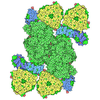
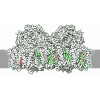

 Z (Sec.)
Z (Sec.) Y (Row.)
Y (Row.) X (Col.)
X (Col.)












































